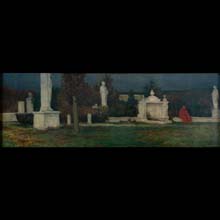
dimensions: 44 × 124,5 cm
description:
Italian Cemetery at Dusk and At Dusk employ the same motif – an urban necropolis with gravestones and grand tombs showing white among trees and bushes in the dark of twilight. The paintings differ in perspective and intensity of light. In other words, the artist selected two moments of dusk trying to capture and convey the gradual disappearance of light and the accompanying visual effects – shapes and colours being engulfed by the deepening darkness. In the first picture, the setting sun is visible as a blood-red glow in the sky, creating strong colour contrasts and providing a disturbing background to the stillness and silence of the city of the dead. The mood has faded away in the second work. The scene is shrouded in delicate, opalescent dimness of the ending day, suffused with a faint gleam of sunlight. The artist has added a touch of colour for contrast – the figure of a sitting man in a purplish red mantle.
Luminous and colour effects of this kind aroused the interest of painters of the Munich art circle from the early 1870s, including many Poles who studied there, among others, brothers Maksymilian and Aleksander Gierymski, Józef Brandt, Józef Chełmoński and Adam Chmielowski. They developed a type of mood picture referred to as "stimmung” painting, which embraced landscapes, genre scenes and history paintings as well as images from the world of fantasy. Stimmungsbild (from German ‘stimmung picture’) was expected to be not only a show of the painter’s capability of harmonizing related colours with low scale of intensity and using their nuanced tones, but also to affect the viewer with the mysterious mood, excite his or her imagination, move, as well as trigger contemplation.
Wacława Milewska
exposition: The Gallery of 19th Century Polish Art in Sukiennice,
The Cloth Hall, 1, Main Market Square
key: Realism, polish impressionism, beginnings of symbolism >>>












